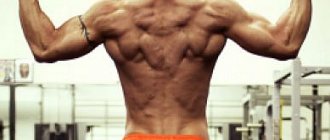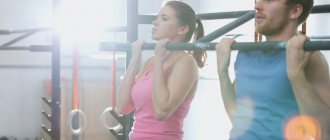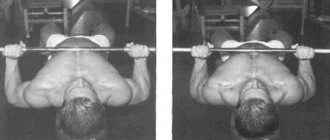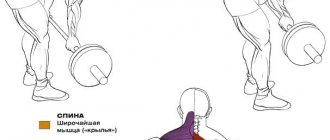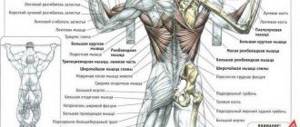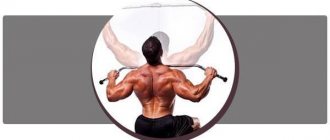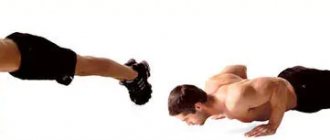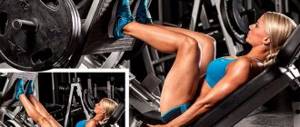Close-grip pull-ups are one of the many variations of the most popular exercise. Its peculiarity is that it no longer works the upper, but the lower part of the so-called “wings”, the latissimus dorsi muscles, and the muscles that are located near the spine. Other muscles are also involved in the work. This exercise, in turn, has a certain number of variations, which allows you to alternate load options. The correct technique is very important to ensure the effectiveness and safety of the exercise.
Features of the exercise
Close-grip pull-ups, as their name suggests, involve placing your hands narrowly on the bar. This slightly shifts the load on the muscles. Pull-ups are an indispensable exercise for those who want to get a beautiful upper body shape. It is mainly popular among men, although female athletes also often include it in their programs.
In addition to stressing the muscles, pull-ups help to form beautiful posture, strengthen the back and spine, thereby ensuring the prevention of numerous diseases.
Another interesting nuance. Many athletes have probably noticed that doing pull-ups with a close grip is much easier than with any other grip. Why is this happening? It's a matter of anatomy. Our muscles are designed in such a way that this position is most convenient for the strongest traction. Therefore, often those who find it difficult to do pull-ups with a standard grip at least ten times can easily repeat narrow pull-ups 12-13 or more times . This makes it possible to use more weight.
Implementation recommendations
- The exercise should be performed at the beginning of a workout aimed at developing the back muscles. It can be performed either as the first exercise, or as the second - after pull-ups with wide or medium hands on the bar.
- The exercise can be alternated with other pull-up variations. For example, in one back workout an athlete performs a variant with a wide grip, and in the next - with a narrow grip.
- Also, a narrow grip can be used in combination with other types of pull-ups, or using the superset and triset technique.
- The optimal scheme for performing the exercise: 3-4 sets of 10-15 repetitions.
What muscles work?
Due to the fact that when performing the exercise, the hands are placed narrowly, the emphasis of the load from the back shifts to the muscles of the arms. The exercise can be performed with a forward, reverse or parallel grip.
First of all, when performing such pull-ups, the following muscles :
- biceps (biceps brachii);
- brachialis muscles (they are located slightly deeper than the biceps muscle and are also called “brachialis”);
- latissimus muscle;
- teres major muscle.
A reverse grip is often practiced, as it works great on the biceps. It can be used as a basic or additional one. Pull-ups with a narrow straight grip distribute part of the load from the biceps to the brachialis muscle. And pull-ups with a narrow parallel grip work the lower region of the latissimus muscles.
If you want to pump up the latissimus muscles, then your program should also include wide-grip pull-ups.
Benefits and contraindications
By regularly performing pull-ups on the horizontal bar with a reverse grip, you will perfectly develop your core muscles and make them stronger. They're also a great accessory to other, more challenging bodyweight exercises, like jumping plyometric pull-ups, angle pull-ups, or two-arm muscle-ups.
Due to a strong grip, the projectile will not slip out of your hands, and your forearms and hands will not get tired before the target muscle group.
However, not everything is so simple with this exercise. Some athletes often have problems with it. Its implementation requires good stretching and mobility of the shoulder joints. If your deltoid muscles are tight, it will be difficult to perform, and in very advanced cases it can even be fraught with injury to the shoulder ligaments or a tear in the deltoid muscle.
You can and should combat this problem, just make it a rule to start any workout with a thorough warm-up and stretching of the shoulder girdle. The most effective exercise for this exercise is cranking your arms with a stick. After a couple of weeks of doing this, you will notice that the shoulder joint has become much more mobile, and any kind of pulling exercises for the back or pressing exercises for the chest and shoulders are much easier and more comfortable.
Also, a heavy load falls on the elbow joints and ligaments. If you have had problems with them in the relatively recent past, it is better to refuse to perform this exercise or replace it with regular pull-ups or lat pull-downs.
Close-grip pull-ups: technique
The most popular option is narrow-grip biceps pull-ups with a reverse grip, so we will consider this technique as a classic one. This exercise is performed as follows:
- Starting position – hanging on the horizontal bar. Keep your arms straight, the distance between the hands is 20-30 cm (less than shoulder width). The peculiarity of the reverse grip is that the thumbs should be turned out, looking in opposite directions. The palms are directed towards you, due to which the biceps receive the maximum load.
- Hanging on the horizontal bar, you should feel a stretch in your back. Take a deep breath.
- Now, making an effort through the target muscles, pull yourself up while exhaling. When you reach the top, the bar should reach about the level of your chin (since with this grip you are unlikely to be able to reach your upper chest). The latissimus muscles contract.
- Then smoothly and slowly return to the starting position. Repeat the exercise as many times as necessary.
As for the number of approaches and repetitions, to begin with, you can do 2-3 sets of 7-12 times , without using additional weights.
While performing the exercises, try not to swing on the horizontal bar - this will reduce the effectiveness of the exercise. Also, try to keep your elbows in one position.
Useful video
After you have completed a pull-up, under no circumstances should you suddenly jump off the horizontal bar, as this can lead to damage and injuries in weightlifting.
We have already talked about weights. To improve results and for better muscle growth, I recommend gradually switching from regular pull-ups to weighted pull-ups.
Don't forget about proper technique. It is better to do 5-6 pull-ups with the correct technique than to do 15 pull-ups that are of no use.
To learn how to do pull-ups, I recommend starting with partial pull-ups. In fact, it's not all that difficult. It’s not uncommon to meet people who couldn’t do pull-ups today, but after a couple of months their result exceeds 10 repetitions.
Another very good thing is statics. This is the position in which you must stay on the horizontal bar, usually when your chin passes over the bar, you need to hang using the muscles of your arms. In this case, the muscles quickly remember the tension, which subsequently affects performance.
When pulling up, the horizontal bar must be at shoulder level, then this pull-up will be counted as correct.
Before pull-ups, as before any other workout, I recommend warming up thoroughly. This will help prevent injuries and reduce the chance of damage and tears to ligaments or muscle fibers. If you have problems with joints or ligaments, you can use elastic bandages, which are great for heavy loads.
In order to diversify the load, I recommend head pull-ups. There is also another good option with an opposite grip to the chest, in this case the back muscles are well worked.
If you have mastered training on the horizontal bar with various grips, try yourself on a rotating horizontal bar.
Dear friends, our topic today about pull-ups has come to an end. We talked about the main nuances, looked at the technical nuances, I told you the correct pull-up technique, and gave practical, useful recommendations that will help you achieve beautiful and massive biceps.
This technique can be applied to any kind of pull-up. I recommend watching an interesting video that contains useful information. See you later.
Alexander Bely
As mentioned above, reverse grip pull-ups are a basic exercise. Is it good or bad? What are the differences in muscle work from pull-ups with a straight wide grip?
Basic exercises are those in which movement occurs in more than one joint, and several muscle groups are involved in the work. In the pull-ups we mentioned, movement occurs in the elbow and shoulder joints, and in addition to the biceps, the latissimus dorsi muscles help raise and lower the torso relative to the bar.
Isolation exercises involve movement in only one joint and maximally involve only one muscle group. Think about barbell curls or hammer curls. Movement occurs exclusively at the elbow joint. In addition to the biceps, core stabilizers are involved in the work, but they are not taken into account.
The advantage of basic exercises is that they:
- They load more muscles, therefore allowing for greater strength load. Basic exercises allow you to work out your muscles in a comprehensive manner, increasing the overall effectiveness of your workout; they form the basis of most training programs.
- The load is distributed between several joints, which reduces the load on each of them individually.
- Coordination skills and overall coordination of movements are developed.
Isolation exercises are designed to:
- Maximum load on the target muscle, turning off everything else. In other words, when performing them, you spend less energy and use less weight, but the entire load goes into the selected muscle.
Returning to our exercise, we can say that pull-ups comprehensively train both the arms and the back. But, using a reverse grip and narrow placement of the hands, we focus the load on the biceps, minimally using the lats.
While pull-ups with a straight wide grip, on the contrary, remove the load from the arms and put maximum load on the back. Additionally, when doing pull-ups with both a reverse narrow grip and a straight wide grip, the abs, shoulders, and forearms work.
Next, we will move on to reviewing the pull-up technique. But first, it’s worth saying a few words about why compliance is more important than the number of repetitions. And this is not only about injuries to the shoulder joints and spine, which can be obtained by performing jerking movements or jumping from the horizontal bar to the ground.
Under any load, in any exercise, exhalation is always performed with effort. Thus, from the beginning and to the peak of contraction, you need to exhale, and in the negative phase (relaxation) - inhale. Therefore, when pulling yourself up to the bar, you exhale powerfully, and when you straighten your elbows, you inhale smoothly.
If an athlete is still just mastering pull-ups with his own weight, even from scratch, it is important to always test the load “until the muscles fail”; on the last repetitions, it is necessary to pull up with all your might until the muscles refuse to work. What matters is what goals the athlete pursues.
- If an athlete is training power and strength, it is necessary to perform 3-6 repetitions per set, you can work with additional weight.
- If the goal is to increase muscle volume, then 8-12 repetitions should be performed.
- And if you need to increase endurance, speed, and simply work on quantity, perform 15 repetitions or more.
For training to be beneficial, train your back no more than 1-2 times a week. The large back muscles take 5-6 days to recover, so do not rush to do pull-ups until the muscles have fully recovered. The optimal number would be 3-4 approaches.
Types of pull-ups with a narrow grip
There are different variations of the exercise. So, pull-ups with a narrow straight grip are practically no different from the opposite, except for the fact that the palms are turned away from you rather than towards you. In this case, the load shifts from the biceps to the back. As for the parallel grip, the lower latissimus muscles work primarily here.
If pull-ups are easy for you and you can repeat them more than 10-15 times without problems, you can use additional weights. Usually, in the case of this exercise, heavy plates or weights are used, and in the second option, special care is needed. The load is secured to the belt or legs. Another option is to use a backpack filled with something heavy. Put it on before you begin the exercise.
The classic close-grip pull-up on the horizontal bar is not the only option that can be included in the training program. You can use interconnected D-shaped handles for pull-ups. In addition, good results are obtained by performing exercises on parallel bars, which are located close to each other, and the height of which must be adjusted.
Despite the fact that pull-ups with a narrow grip are easier than with a wide grip, they can be quite difficult for beginners. The same applies to girls, whose hands are much weaker than those of men. The best option may be narrow reverse grip rows on a special simulator. The movement in this case will be the same, but the weight that will be used in the work will be less than its own. This option, such as pulling up in a gravitron with a narrow grip, helps to effectively work the muscles and prepare them for greater load.
However, there is another option that will allow beginners to start doing pull-ups right away, without a machine. It involves the use of special tourniquets attached to the crossbar and legs. Thus, the load when pulling up will be significantly lower, since the weight will be reduced. When you master this version of the exercise freely, you can move on to regular pull-ups.
Useful tips
Close-grip pull-ups must be performed using the correct technique - only then will they bring results.
- Pull-ups are carried out only through muscle strength.
- Raise and lower the body smoothly, without sudden movements.
- The exercise is done while inhaling.
- During training, the torso is held vertically, without tilting it to either side.
- The pace should be even.
- It is necessary to monitor not the quantity, but the quality of exercise.
- At first, when the exercise is difficult, you can use outside help - a partner can hold the person doing the pull-up and push him up a little. This will help you master the technique faster.
- With proper experience, training can be complicated by using weights at the waist or squeezing the shoulder blades together at the top of the lift.
- The home horizontal bar is not placed too high to eliminate the risk of injury during exercise.
- During pull-ups, you need to focus on working the muscles.
- Elbows must be strictly fixed.
- Do not swing during exercises.
In order for pull-ups in the gravitron to bring only benefits, you should first hone the technique. You need to increase the complexity of your workouts gradually and consistently as your physical strength develops. And in order to achieve harmonious muscle development and an athletic physique, it is necessary to alternate pull-ups with a narrow and wide grip.
Contraindications and precautions
Pull-ups are a useful and effective exercise, but not everyone can do them. First of all, those who suffer from scoliosis (curvature of the spine), as well as intervertebral hernias and protrusions, should refrain from performing it. Caution is needed for osteochondrosis. Despite the fact that pull-ups improve blood circulation and increase the mobility of spinal structures, which is important for such a diagnosis, they can put too much stress on the spine, which will lead to degenerative changes. With osteochondrosis of the cervical spine, pull-ups can provoke dizziness and pain.
At first, it is difficult for beginners to do at least a few correct repetitions of the exercise. And the following list of factors :
- Overweight. Excess weight puts additional stress on the muscles, even if they are sufficiently developed. Therefore, it is initially recommended to lose weight, and only then begin to pull yourself up - this way you will significantly reduce the risk of injury.
- Physical weakness. Even at a normal weight, mastering pull-ups from scratch can be difficult. This will require some strength and endurance, so train them.
- Weakness of accessory muscles. Biceps, latissimus dorsi and other muscles belonging to the main groups are not all that is needed to master pull-ups. It is also necessary to develop auxiliary groups, namely, the pectoral muscles, radial muscles, posterior deltoid muscles, and so on.
- Technique . The technical aspect is also important - it is the undeveloped technique that often prevents beginners from mastering pull-ups. It needs to be brought to perfection so that the muscles are worked out efficiently and the risk of injury is minimized. That is why, to begin with, try to focus on quality rather than quantity.
The correct pull-up technique has been described above, but there are a few more points to consider:
- You need to pull yourself up solely using muscle strength. Lifts should be smooth, without jerking or swaying, without the use of inertia.
- You also need to lower your body smoothly . The times of ascent and descent should be approximately the same.
- Breathe correctly : you need to go up as you inhale, and go down as you exhale.
- During the exercise, keep your body strictly vertical.
- The narrow grip is intended mainly for working out the arms . If you want to pump up your back as well, use a wide one.
- If you have some experience and good training, you can use weights, attaching them to your belt.
- The load on the biceps only makes sense when using a reverse grip. In other options, you should work with your body, not your hands.
- If you have recently started doing pull-ups on the horizontal bar, and it is still difficult for you to perform the movement in full amplitude, you can ask your partner for help. He can hold your legs and push you towards the bar - this will help you master the correct technique.
- Throughout the entire exercise, keep your back straight and your body straight.
- When practicing on a low-ceilinged bar, be careful not to hit your head at the top.
- When performing pull-ups, focus on working the target muscle. Experts confirm that the mental connection between the muscles and the brain is no less important than the direct technique of execution.
- When you reach the top of the lift, try to bring the “wings” together.
- Before using weights or practicing advanced types of pull-ups, make sure that you have perfectly mastered the classic technique. There is no need to rush to increase the load and chase the number of repetitions.
A little more about why it is important to avoid rocking when performing pull-ups. In this case, non-target muscles will receive the load, which will greatly reduce the effectiveness of the exercise. You don't need to help yourself this way. The chest should be pushed forward, the back can be slightly arched at an angle of about 30 degrees, but not bent. You cannot swing your body or jerk your legs.
Correct technique
This type of pull-up is always performed in a parallel style with the palms facing each other. This type of grip makes it possible to better load the lower part of the latissimus dorsi muscles. To achieve good results, you must follow the following technique:
- Approach the horizontal bar and grab it with both hands with a narrow grip.
- It is important to calm the body so that it does not sway from side to side.
- The legs should be in a free position, but it is not recommended to bend them. Lifting the body is performed solely through the strength of the arms.
- Pull-ups begin until the chest touches the bar. It is very important that the touch occurs using the chest and not the chin, since only in this case the latissimus dorsi muscle comes into action as well as possible.
- The downward movement of the body is slightly shortened, but in no case should you “throw” it down.
If the exercise is performed correctly, then with its help you can make yourself a strong back and biceps. The effect of pull-ups becomes noticeable after a few weeks of regular training. It is important to gradually increase the load so that the biceps and back do not get used to monotonous exercises.
Bottom line
Regardless of whether you decide to use a forward or reverse grip pull-up, stick to the correct technique, or better yet, alternate between both of these exercises. Only in this case will the load on the back muscles be distributed evenly. If you notice that one side of your back is not developing as quickly as the other, compensate for the load with pull-ups on one arm, or use unilateral rows to the dumbbell belt
